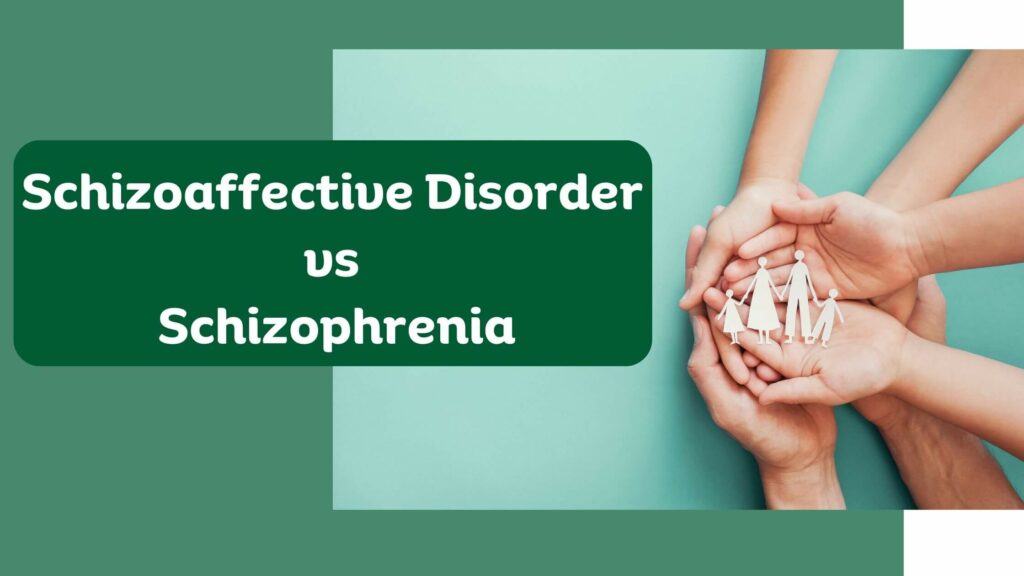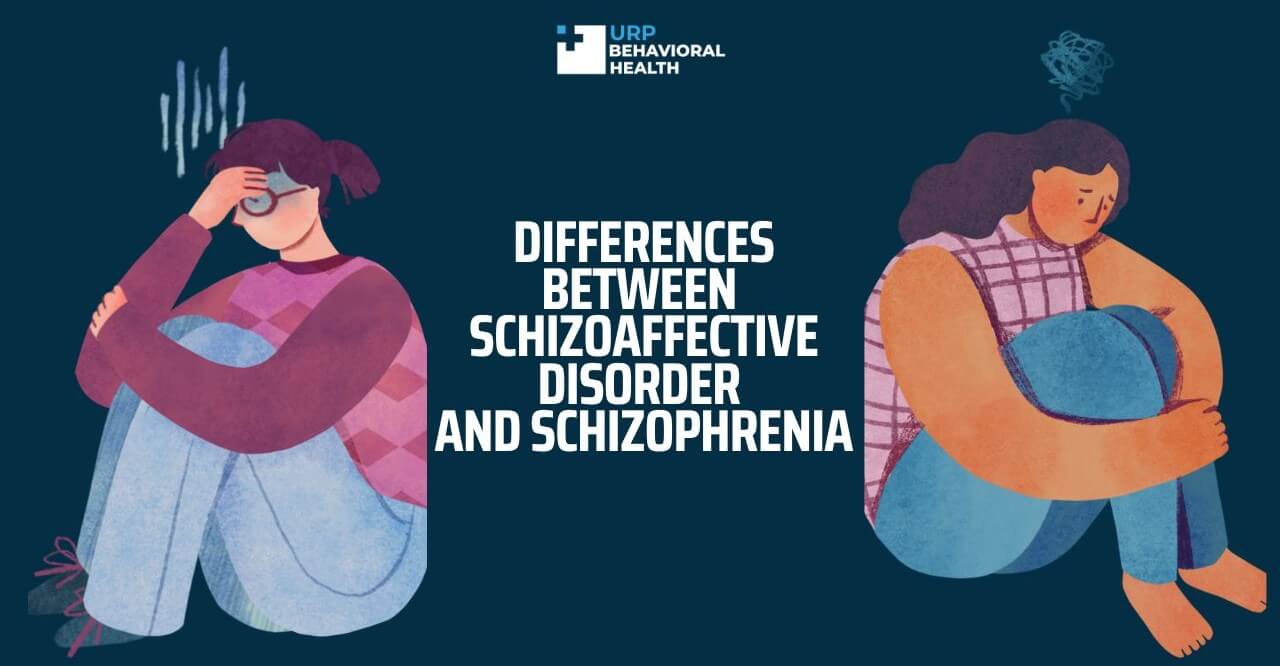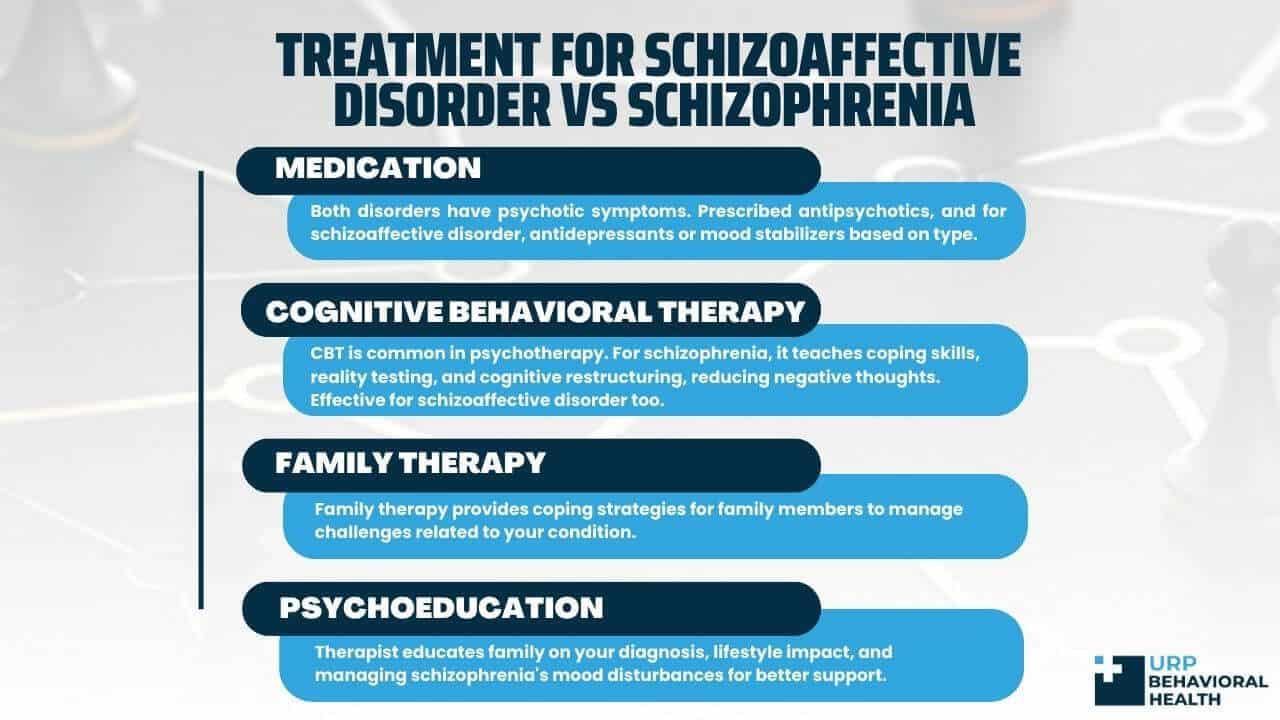Schizoaffective Disorder vs Schizophrenia

When you have psychotic symptoms, the experience can be challenging, frustrating, and isolating. Nevertheless, seeking appropriate treatment and getting professional support can help you become a community member and lead a fulfilled life. But for that, the right diagnosis is necessary. Statistics by the World Health Organization show that schizophrenia affects about 1 in 300 people, a rate of 0.32 percent.
In comparison, schizoaffective disorder affects far fewer people because of its similarity with schizophrenia and bipolar disorder. This can lead to inaccurate diagnosis and, consequently, improper care. Let’s look at the differences between schizoaffective disorder and schizophrenia to understand its symptoms, diagnosis, and treatment provided at URP Behavioral Health.

Similar Symptoms of Schizoaffective Disorder vs. Schizophrenia
Since both conditions are psychotic disorders, they share a few similar symptoms. Let’s have a look at the similarities and differences in the symptoms. For a diagnosis of schizoaffective disorder, you need to exhibit criteria A, which includes at least two of the following, one of which should be the first, second, or third:
- Delusions
- Hallucinations
- Incoherent speech
- Disorganized behavior
- Negative symptoms like reduced emotional expression
These symptoms overlap between schizoaffective disorder and schizophrenia. Other similarities involve ruling out the effect of a medical condition or substance abuse. Also, both conditions are attributable to a significant disturbance in social, occupational, and other areas of functioning.

Difference Between Schizophrenia and Schizoaffective
The main difference is that, in schizoaffective disorder, you experience a major mood episode as well. Meanwhile, for a diagnosis of schizophrenia, the disturbance should persist for at least six months from the onset.
For schizoaffective disorder, you must experience hallucinations or delusions for 2 weeks or more without a major mood episode. Other than that, you should show symptoms that meet the criteria for a major mood episode for the majority of the duration of your condition. The symptoms of a major mood episode can vary depending on whether you have the depressive type or bipolar type.
In the bipolar type, you have both depressive and manic episodes. The former involves low mood, loss of pleasure in activities you previously enjoyed, and a lack of function. The latter is characterized by high levels of energy, which can manifest in the form of sleeplessness, grandiose delusions, and a flight of ideas.
Differential Diagnosis
While the criteria for schizophrenia excludes a major mood episode, people with the condition can develop low mood due to the difficulty of living with the disorder. Thus, it becomes challenging to make an accurate diagnosis.
The Fifth Edition of the Diagnostic and Statistical Manual of Mental Disorders by the APA provides a differential diagnosis. The presence of criteria C can differentiate between schizophrenia and schizoaffective disorder.
Criteria C requires you to show symptoms of a major mood episode for a majority of the active (when you display psychotic symptoms) and residual (when psychotic symptoms are absent) periods of the illness.

Treatment for Schizoaffective Disorder vs Schizophrenia
Medication
Since both disorders feature some form of psychotic symptoms, our psychiatrists prescribe antipsychotics for both conditions. In the case of schizoaffective disorder, there’s a need for antidepressants or mood stabilizers. This will depend on whether you have a depressive or bipolar type.
Cognitive Behavioral Therapy
During individual psychotherapy, mental health professionals can take different approaches, but the most common is CBT. The therapy is based on the notion that psychological problems occur as a result of faulty thought patterns and learned patterns of behavior.
When used to treat schizophrenia, therapists rely on techniques such as teaching coping skills, self-monitoring, reality testing, and, most importantly, cognitive restructuring. You’ll develop certain skills that help you tell what’s real and change the way you think to reduce negative thoughts. Thanks to these techniques, CBT is useful in situations where medication isn’t as effective at managing psychotic symptoms.
Since schizoaffective disorder comprises mood disturbances, CBT is a highly effective method because how it helps you form a connection between your thoughts, behavior, and symptoms. Using cognitive restructuring, you’ll be able to modify negative thought patterns that contribute to your depressive mood. And if you have bipolar-type schizoaffective disorder, CBT helps you develop skills to manage the severity of manic symptoms.
Family Therapy
Besides medication and individual psychotherapy, family therapy and psychoeducation are other essential aspects of inpatient treatment. During family therapy, you’ll attend sessions with family members, such as your parents, siblings, or spouse, to talk about how the home environment potentially affects your condition and vice versa.
Your therapist will provide your family members with effective coping strategies. These help your family members cope with challenging and stressful situations that may occur as a result of your condition.
Psychoeducation
Your therapist will also take the opportunity to inform them about your diagnosis and how it can affect your lifestyle. Studies show that having a better understanding of the condition itself makes it easier for people to manage it. At the same time, it encourages their loved ones to provide support. The difference is that, in schizophrenia, your therapist will also inform your loved ones about potential mood disturbances and how they can help you manage them.
FAQs
Some of the most commonly asked questions about schizoaffective disorder vs. schizophrenia are as follows:
The main difference between both conditions is that schizoaffective disorder includes a mood disturbance. It can be in the form of a manic or depressive episode and is accompanied by psychotic symptoms, just as in schizophrenia.
According to the National Alliance on Mental Illness, schizoaffective disorder is quite rare. It has a lifetime prevalence rate of only 0.3 percent, but it’s common for people with schizoaffective disorder to be misdiagnosed with bipolar disorder or schizophrenia.
Common treatments used for both conditions include family therapy, individual psychotherapy, and medication such as antipsychotics. The difference is that people with schizoaffective disorder may require medication to alleviate depressive or manic symptoms.
References
- https://www.ncbi.nlm.nih.gov/pmc/articles/PMC2811142/
- https://www.who.int/news-room/fact-sheets/detail/schizophrenia
- https://www.nimh.nih.gov/health/topics/schizophrenia
- https://www.ncbi.nlm.nih.gov/pmc/articles/PMC8394638/
- https://www.ncbi.nlm.nih.gov/books/NBK541012/
- https://www.ncbi.nlm.nih.gov/pmc/articles/PMC8078408/
- https://www.ncbi.nlm.nih.gov/pmc/articles/PMC2719459/
- https://www.ncbi.nlm.nih.gov/pmc/articles/PMC4298308/
- https://www.ncbi.nlm.nih.gov/pmc/articles/PMC8498814/
Let us guide you towards healing
We know that seeking treatment can be overwhelming, but our staff is here to make the process as smooth as possible. We’re available 24/7 to address any questions or concerns you may have.

